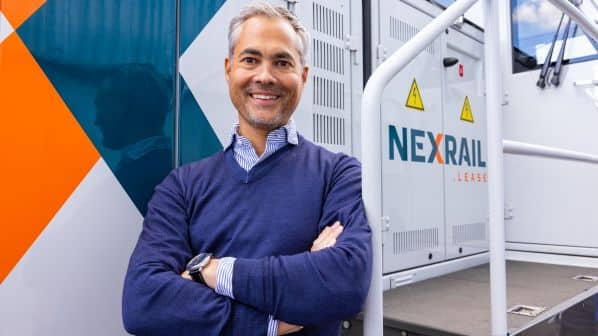FOUNDED in 2021 by Mr Luuk von Meijenfeldt and Mr Mark Remie (pictured), Nexrail has found its niche in the locomotive leasing market by providing centre-cab locomotives with a focus on more environmentally-friendly traction options.
Nexrail Lease, Infravia Capital Partners and Vossloh Rolling Stock (VRS) confirmed an exclusive agreement in September 2021 to transfer existing locomotives operating under lease by European operators in Germany, France, Italy, Belgium and Luxembourg into a single pool overseen by Nexrail. The newly-formed rolling stock leasing company also agreed a framework contract for up to 120 new DE 18 Stage V Smart Hybrid locomotives from VRS.
Nexrail says it is looking to provide the most modern and clean locomotive fleet in Europe within the next five years, targeting European customers including in Britain, and users of Spain and Portugal’s Iberian gauge network. Its fleet is compatible with hydrotreated vegetable oil (HVO) diesel, which offers up to 90% of net CO₂ emission savings while the smart hybrid DE 18s will be equipped with battery traction for first and last mile and slow-speed operation.
Remie says Nexrail sits in a unique position between manufacturer and operator, which allows it to drive innovation and embrace new technology such as battery traction. “We encouraged Vossloh to develop the smart hybrid DE 18 with a 72kWh battery,” he says.
“We push the manufacturer towards new technologies. We increase the pressure because we come up with money for investment and we think long term about possible modifications to our vehicles to keep up with the latest technology.”
“Electricity is a scarce commodity. The overhead lines on some routes are overloaded and that limits the use of electric traction, while the line itself may have enough capacity.”
Mark Remie
Indeed, Nexrail is looking to advance this strategy in its next round of investment.
For example, it recently signed a memorandum of understanding (MoU) with Wabtec, which is interested in bringing its battery experience to the European market. One of the ambitions is to develop a locomotive that can haul a freight train for more than 150km on battery, and can be charged using the overhead line. Work on separate designs for continental Europe and Britain is planned.
“Electricity is a scarce commodity,” Remie says. “The overhead lines on some routes are overloaded and that limits the use of electric traction, while the line itself may have enough capacity.”
Nexrail is calling for the widespread adoption of partial electrification, which uses catenary islands that allow a battery to be charged before continuing on a non-electrified section to the next island. The system is being installed in northern Germany, and Nexrail is urging other European infrastructure managers to follow suit.
Nexrail has adopted a similarly flexible approach to maintenance. It acquired locomotive maintenance provider LocMaint to expand the company’s support network while Nexrail employs its own “flying doctors,” engineers who can use a customer’s own maintenance facility to solve difficult issues that require specialist attention. All contracts are based on a full-service lease and Nexrail regularly outsources some work to the customers’ workshop. “In this way, Nexrail keeps everything under control and maintenance can be efficiently organised and carried out over a large area, close to where the locomotives operate,” Remie says.
Market barriers
Even though Nexrail is purchasing modern locomotives equipped with the latest technology, there are still barriers to introduction, with ETCS a particular sticking point. Locomotives are being delivered with a hodgepodge of signalling solutions designed for particular corridors or sections of the European network, which prevents cross-border acceptance of ETCS.
For example, Nexrail explored purchasing Italian locomotives equipped with ETCS Level 2 with a view to using them in Denmark. However, differing ETCS baselines prevented this from happening. Going through the vehicle authorisation process also proved economically unfeasible.
“Surely this was never the intention of ETCS?” Remie asks. “The lack of unity in ETCS is a serious problem for the European rail sector. We want clarity about possible investment. In the Netherlands, with its ATB national train protection system, you are out of the game. The Netherlands says it supports the ATB variant of ETCS. That’s nice, but how should we integrate that into our locomotives? I would prefer to order locomotives with only ETCS.”
It’s not just the interoperability benefits of ETCS that Remie wants to see. As well as improving safety and capacity, ETCS also improves energy use by allowing drivers to adjust how they operate. Ultimately, Remie says Nexrail is looking for a standard, modular locomotive to which suitable technologies and systems can be added depending on market needs.
“That was the promise of ETCS but it doesn’t actually exist to date, but I foresee that development,” Remie says. “If this is achieved, locomotive introductions will become a lot easier. OEMs will not be dependent on state railway orders anymore. This will help the speed of innovation enormously.”
Ultimately, Remie says national borders within the European network need to be removed as much as possible. He believes this will allow rail to make a substantial contribution to the net zero economy, which will only happen with quick and thorough action.
“Nexrail has aligned its business strategy with these goals and I believe that we will play an important role in the future of rail freight.”

